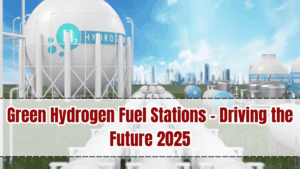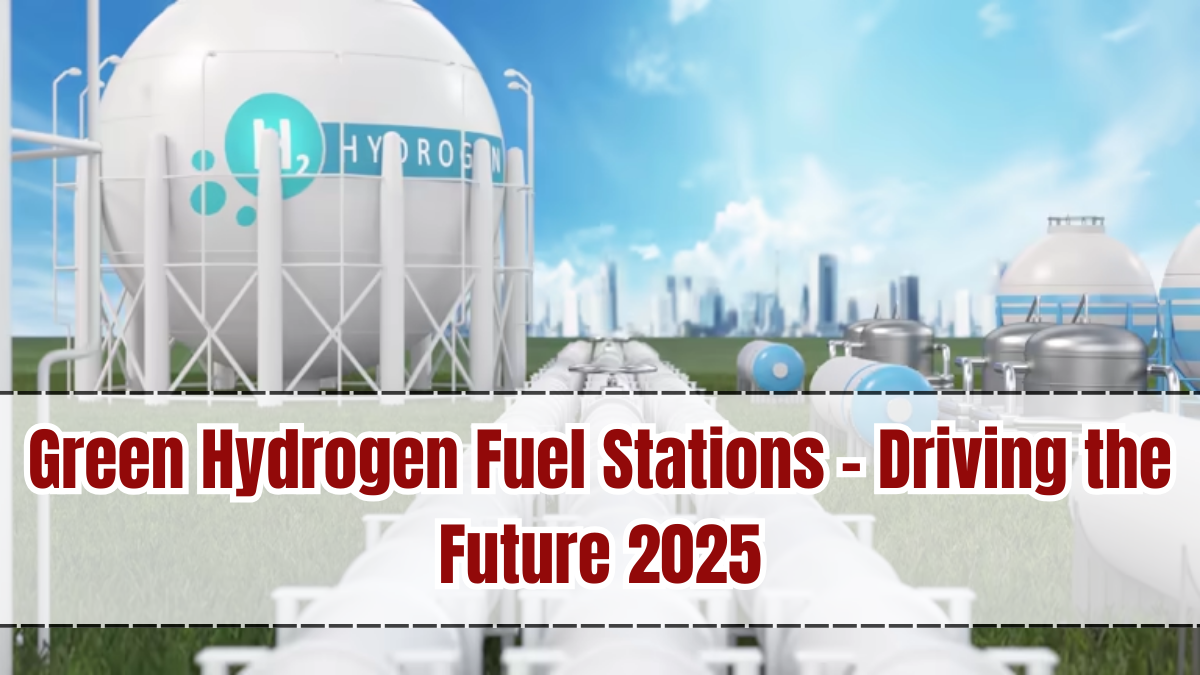As the world shifts toward cleaner mobility, the need for sustainable alternatives to petrol and diesel is stronger than ever. Electric vehicles have already made progress, but in 2025, Green Hydrogen Fuel Stations are emerging as the next big leap in sustainable transport. Using hydrogen produced from renewable sources like wind and solar, these stations provide zero-emission energy that can power cars, buses, and even trucks. They are not only reshaping the transportation sector but also pushing nations closer to their climate goals.

Table of Contents
What are Green Hydrogen Fuel Stations?

A Green Hydrogen Fuel Station is a facility where hydrogen, generated from renewable energy through electrolysis, is stored and supplied to vehicles. Unlike fossil-fuel-based hydrogen, green hydrogen is entirely clean as it produces only water vapor when used in fuel cells.
Key components of these stations include:
-
Electrolyzers that split water into hydrogen and oxygen using renewable electricity.
-
Storage tanks that keep hydrogen at high pressure for safe distribution.
-
Fuel dispensers designed to fill hydrogen-powered vehicles quickly.
This makes hydrogen a strong alternative to conventional fuels, especially for long-distance and heavy-duty transport.
Why Green Hydrogen Matters in 2025
The rise of Green Hydrogen Fuel Stations 2025 is significant for several reasons. First, global transportation is responsible for nearly one-fourth of carbon emissions, and hydrogen offers a zero-emission alternative. Second, hydrogen vehicles can be refueled within minutes, unlike electric vehicles that require long charging times. Finally, hydrogen has the potential to power sectors beyond cars, including aviation, shipping, and heavy industries. This makes green hydrogen a crucial pillar of the clean energy revolution.
Benefits of Green Hydrogen Fuel Stations
The adoption of green hydrogen stations is creating multiple advantages for both the environment and the economy.
-
Zero Emissions: Vehicles emit only water vapor, reducing air pollution.
-
Fast Refueling: Similar to petrol stations, vehicles can refuel in minutes.
-
Energy Security: Countries reduce dependence on imported oil.
Role of Technology
Technology is the backbone of Green Hydrogen Fuel Stations 2025. Advanced electrolyzers powered by solar and wind energy are making hydrogen production efficient and affordable. Modern storage systems maintain hydrogen safely at high pressures, while AI-powered monitoring tools track supply and demand to optimize distribution. In addition, smart grids ensure that renewable energy is directed effectively to produce hydrogen without stressing existing power systems. Together, these technologies are making hydrogen stations reliable and future-ready.
Government and Industry Initiatives
Governments across the globe are actively promoting green hydrogen as a key element of their clean energy policies. Subsidies, tax benefits, and large-scale infrastructure projects are driving adoption. For instance, Europe and Japan have set up hydrogen corridors for buses and trucks, while India and the UAE are investing in hydrogen hubs for public transport. Private companies are also entering the field, with automotive giants developing hydrogen-powered cars and logistics firms experimenting with hydrogen trucks for long-haul routes.
This collaboration between public policy and private innovation is accelerating the shift toward sustainable mobility.
Challenges Ahead
Despite its promise, the adoption of green hydrogen still faces hurdles. Setting up hydrogen stations requires heavy investment, and storage safety remains a concern in some regions. Additionally, the current cost of producing green hydrogen is higher than fossil-fuel alternatives, making it less competitive. However, with scaling, technological advancements, and government incentives, these challenges are expected to reduce significantly by the end of the decade.
Future of Green Hydrogen Fuel Stations
Looking ahead, green hydrogen stations are set to play a critical role in the global energy transition. By 2030, experts predict:
-
Hydrogen corridors connecting major cities and highways.
-
Integration of hydrogen stations with EV charging hubs for hybrid solutions.
-
Increased use in aviation and shipping, beyond road transport.
-
Blockchain-enabled tracking systems ensuring transparent supply chains.
As costs continue to fall, hydrogen will move from being a niche solution to a mainstream fuel option worldwide.
Conclusion
Green Hydrogen Fuel Stations 2025 represent a powerful step toward sustainable transport. They offer speed, scalability, and true zero-emission mobility that goes beyond the limitations of conventional electric vehicles. With strong government support, private innovation, and advancing technologies, hydrogen is becoming the fuel of the future. While challenges remain, the momentum in 2025 shows that the shift from fossil fuels to green hydrogen is no longer optional — it is inevitable.
FAQs
What are Green Hydrogen Fuel Stations?
They are facilities that produce, store, and supply hydrogen generated from renewable energy sources for vehicles.
Why are hydrogen stations important in 2025?
They provide a zero-emission alternative to fossil fuels, reduce carbon footprints, and support sustainable transport systems.
How do hydrogen vehicles compare to electric vehicles?
Hydrogen vehicles can be refueled within minutes and are better suited for long-distance and heavy transport, while EVs often require longer charging times.
Is hydrogen safe for daily use in vehicles?
Yes, modern hydrogen stations use advanced safety systems and storage technology to ensure secure handling and fueling.
What is the future of hydrogen fuel stations?
The future includes global hydrogen corridors, integration with EV hubs, and adoption across shipping, aviation, and industrial sectors.
Click here to know more.






